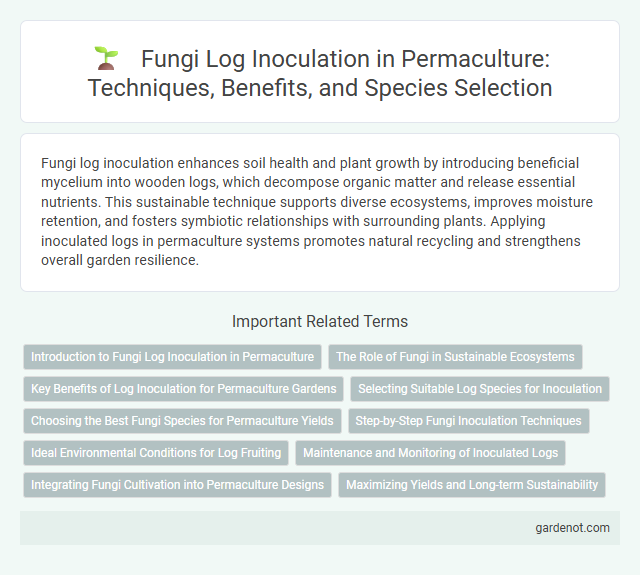Fungi log inoculation enhances soil health and plant growth by introducing beneficial mycelium into wooden logs, which decompose organic matter and release essential nutrients. This sustainable technique supports diverse ecosystems, improves moisture retention, and fosters symbiotic relationships with surrounding plants. Applying inoculated logs in permaculture systems promotes natural recycling and strengthens overall garden resilience.
Introduction to Fungi Log Inoculation in Permaculture
Fungi log inoculation is a sustainable technique in permaculture that enhances soil health by introducing beneficial mycelium into wood substrates, promoting nutrient cycling and plant growth. This method involves embedding spawn from mushroom species such as shiitake or oyster onto prepared logs, creating a natural ecosystem that supports biodiversity and organic matter decomposition. Implementing fungi log inoculation increases crop resilience and supports a self-sustaining agricultural environment by harnessing fungal symbiosis.
The Role of Fungi in Sustainable Ecosystems
Fungi play a crucial role in sustainable ecosystems by breaking down organic matter and recycling nutrients, enhancing soil fertility and structure. Log inoculation with mycorrhizal and saprophytic fungi accelerates decomposition processes, promoting healthy plant growth and biodiversity. These symbiotic relationships contribute to carbon sequestration and soil health, vital components in permaculture systems.
Key Benefits of Log Inoculation for Permaculture Gardens
Log inoculation enhances soil fertility by introducing mycorrhizal fungi that improve nutrient uptake and water retention in permaculture gardens. It promotes biodiversity through natural decomposition processes, enriching the ecosystem with beneficial microorganisms. This sustainable method supports plant health and resilience, reducing the need for chemical fertilizers and fostering a balanced garden environment.
Selecting Suitable Log Species for Inoculation
Selecting suitable log species for fungi log inoculation involves choosing hardwoods such as oak, maple, or beech, which provide optimal nutrients and moisture retention for mycelium growth. Softwoods generally contain resin and lack the dense fiber structure needed for sustained fungal colonization, making them less effective for inoculation. The age of the log and its moisture content also significantly impact colonization success, with logs cut within six months and maintaining 40-60% moisture preferred for inoculation.
Choosing the Best Fungi Species for Permaculture Yields
Selecting the best fungi species for permaculture yields involves prioritizing mycorrhizal fungi such as Glomus intraradices, which enhance plant nutrient uptake and soil health. Oyster mushrooms (Pleurotus ostreatus) and shiitake mushrooms (Lentinula edodes) are highly effective for log inoculation due to their rapid growth and ability to decompose hardwood logs. Incorporating native fungal species optimizes symbiotic relationships, improving crop resilience and long-term soil fertility in permaculture systems.
Step-by-Step Fungi Inoculation Techniques
Fungi log inoculation involves drilling evenly spaced holes into hardwood logs, typically using an 8-12 inch length with pre-drilled holes about 4 inches apart. Sterilized fungal spawn plugs or sawdust spawn are inserted into these holes and sealed with wax to prevent contamination and moisture loss. Logs are then placed in a shaded, moist environment to encourage mycelium growth, which can take several months before fruiting bodies appear.
Ideal Environmental Conditions for Log Fruiting
Ideal environmental conditions for fungi log inoculation include maintaining consistent moisture levels between 60-70% and temperatures ranging from 55degF to 75degF to promote mycelial growth. Logs should be kept in shaded, humid environments with adequate air circulation to prevent mold and ensure successful fruiting body development. Optimal hardwood species such as oak or maple provide rich nutrients, enhancing the efficiency of fungal colonization and yield.
Maintenance and Monitoring of Inoculated Logs
Maintaining inoculated fungi logs requires consistent moisture levels between 40-60% to promote optimal mycelium growth and prevent contamination. Regular monitoring for signs of colonization success, such as white mycelial expansion and absence of competing molds, ensures healthy development. Protecting logs from extreme weather and pests also supports sustained fungal health and productivity in permaculture systems.
Integrating Fungi Cultivation into Permaculture Designs
Fungi log inoculation enhances soil health and nutrient cycling by introducing beneficial mycelium into permaculture systems, promoting symbiotic relationships with plants. Integrating fungi cultivation into permaculture designs supports natural decomposition processes, improves water retention, and increases biodiversity within food forests and garden ecosystems. This method also offers sustainable yields of edible mushrooms, which contribute to food security while maintaining ecosystem balance.
Maximizing Yields and Long-term Sustainability
Fungi log inoculation enhances soil health by breaking down organic matter and improving nutrient cycling, leading to maximized crop yields over time. This method supports long-term sustainability by fostering a symbiotic ecosystem that reduces reliance on chemical fertilizers and promotes biodiversity. Integrating mycelium networks into permaculture practices ensures resilient plant growth and sustained productivity across growing seasons.
Fungi log inoculation Infographic

 gardenot.com
gardenot.com